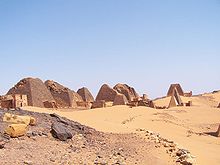Nubian pyramids
The pyramids of the kingdom of Kush (approx. 700 BC - 300 AD) in Nubia are generally referred to as Nubian pyramids . In Nubia there were already smaller pyramids for officials, but these are part of the burial customs of ancient Egypt .
history
The Egyptian pharaohs of the Old and Middle Kingdom (approx. 2700–1650 BC) were buried in pyramids. The pyramid shape as a tomb was the prerogative of kings, queens and in the Middle Kingdom also of princesses. In the New Kingdom (1550–1050 BC) the pharaohs were buried in large underground rock tombs in the Valley of the Kings . The pyramid shape has now been adopted by private individuals; so she lost her royal character. High officials erected small pyramids next to or above their tombs. These small pyramids were also built in Nubia , which was then an Egyptian province. These pyramids are much smaller and steeper than the royal ones of previous eras.
shape
The first Nubian rulers were buried under small mounds found near Al-Kurru . These facilities have been heavily robbed . None of these hills can be assigned to a king with certainty. Pianchi is the second Nubian ruler to rule at least partially over Egypt, and it is also the first Nubian king to choose the pyramid shape for his tomb. The reasons for choosing this grave shape are not known. However, two reasons seem likely:
- The pyramid shape was a recourse to the time of the Egyptian Old and Middle Kingdom, which was felt to be classic and exemplary. In fact, it can be observed in many areas that these epochs were copied by the Nubians. This is especially true for the sculpture and the relief. Unlabeled statues of the (Nubian) 25th and (Egyptian) 26th dynasties are often difficult to distinguish from those of the Middle Kingdom, and there are examples that grave decorations have been copied almost one to one. This recourse seems all the more likely when choosing the pyramids, as this tomb shape begins exactly at the time when the Nubian kings ruled parts of Egypt and thus also saw the pyramids in the north of the country with their own eyes.
- Another reason for resorting to the pyramid shape may be that at that time there were still many official pyramids from the New Kingdom in Nubia, whose tradition was simply continued with the construction of new pyramids. This argument also seems to be dictated by the particular pyramid shape. The official pyramids of the New Kingdom and the pyramids of the Nubian rulers both have the steep inclination with which they differ from those of the Old Kingdom in Egypt.
The pyramids consist of three parts:
- The actual pyramid, which was initially made of stone and later also made of brick in Meroe.
- There is a small mortuary temple in front of the pyramid. In Nuri and el-Kurru this is usually decorated with a stele and a sacrificial table. In Meroe it becomes a custom to decorate this temple richly with reliefs.
- The actual burial chambers are under the pyramid. The entrance is in front of the temple, there are no rooms within the actual pyramid structure. The kings had a tomb system with three chambers, the later kings only a two-chamber tomb. The chambers are sometimes decorated with paintings and long religious texts, especially in the older pyramids.
The royal pyramids can be divided into four groups based on their size. The first group (approx. 700–450 BC) dates from Pianchi to Amanistabara-qo . The pyramids have a side length of approx. 27 m. In the second group (approx. 450-300 BC) ( Siaspi-qo to Nastasen ) the side length is approx. 26 m. Under Arakamani (about 280 v. Chr.) To Amanishakheto (0 to v. Chr.) Shrinks the average side length of 18 m. In the last group (from Natakamani approx. 50 AD) the sides are on average only 6.6 m long. During this time the pyramid building lost its importance.
location
The Nubian pyramids are mainly in four places: Pyramids of Meroe near Meroe , pyramids of al-Kurru south of Meroe, pyramids of Jebel Barkal on Jebel Barkal and further north the pyramids of Nuri .
See also
literature
- Dows Dunham : El Kurru. ( The Royal Cemeteries of Kush, Volume 1). Harvard University Press, Boston 1950.
- Dows Dunham: Nuri . ( The Royal cemeteries of Kush, Volume 2) Museum of Fine Arts, Harvard University Press, Boston 1955.
- Dows Dunham: Royal tombs at Meroë and Barkal. ( The Royal Cemeteries of Kush , Volume 4) Museum of Fine Arts, Boston (Mass.) 1957 (Reprint: Museum of Fine Arts, Boston 1980, ISBN 0-87846-050-0 ).
- Dows Dunham: The West and South Cemeteries at Meroe. ( The Royal cemeteries of Kush, Volume 5). Museum of Fine Arts, Harvard University Press, Boston 1963.
Web links
- Dows Dunham: Recollections of an Egyptologist. Museum of Fine Arts, Boston 1972 (PDF file; 7.49 MB)

